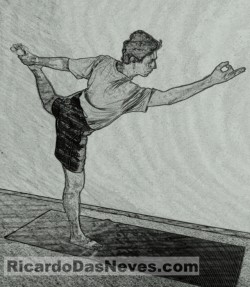Want to stay mentally young? Balance on one foot.
I don’t remember where I got this particular tidbit of information amid my reading on physiology, brain functioning, and general health, but of the 204 billion cells or so that scientists tells us we have in our brains (give or take a billion, depending on how soon you left behind your college drinking days), about 50 billion of them, entire networks of neurons, light up each time we balance.
True, you have to take this a little bit on faith, since I didn’t stop to count each one of them last time I balanced, but with current brain imaging technology, it’s possible to see roughly 25 percent of our neurons activate just from balancing.
And neural networks that light up often remain well-lubricated, so to speak. In the old use-it-or-lose-it adage for retaining our abilities, that’s a lot to gain just from one position.
You could balance however you want, but here for your consideration is the traditional King Dancer Pose ratcheted a bit for greater effect. In two quick steps:
1. Given how common the pose is, I’m assuming you already know that King Dancer, or Natarajasana, involves stepping forward with, say, your right foot, spreading out the toes and the arch of the right foot, shifting most of the weight of your body to the right foot till you then bend the left knee and grab the left ankle with your left hand. You lean forward with the right arm extended as pictured, and lift your left leg to wherever you can go.
2. The King Dancer on Steroids is leaning forward and down, keeping your right hand just slightly off the floor. I like to keep the mudra, or hand gesture, of the thumb and index touching in a small circle, as pictured here.
The leaning forward and down part highly intensifies the stretch to your right hamstring and your left quadriceps and gives you a whole different perception of balance as compared to the standard version of this pose.
Your brain has to learn anew how to balance in this variation, and it’s this kind of “learning” the new distribution of weight that makes for more neurons firing up and keeping neural networks alive and well.
Stay in this position for five slow breaths, and then repeat on the other side.
That’s all. But until you try it, you might not realize how challenging this position can be.
Benefits: Fantastic stretch of the hamstring on one leg and the quadriceps on the other. Fantastic builder of balance as well. Your focus becomes razor-sharp, and there’s so much going on in your body that your mind tends to become quiet of its own accord.
Avoid if: Your ability to release your ankle and drop your foot isn’t fast enough to prevent you from falling should you lose your balance (you could still do it, just flanked by a couple of chairs whose backs you can hang onto if needed). Also avoid if your knees hurt with this position or if just grabbing the ankle feels problematic. You can always pick other poses from my VisualYogaBlog collection that are not as demanding.
Final Thoughts: If you’re reading this in Argentina, you should try the King Tango Dancer Pose instead. Grab some unsuspecting member of the public near you, stick a long-stemmed rose in their mouth, and get them to do this pose with you while hopping to a six-count.
Love elephant and want to go steady?
Sign up for our (curated) daily and weekly newsletters!
Editor: Catherine Monkman
Photo: Author’s Own












Read 1 comment and reply